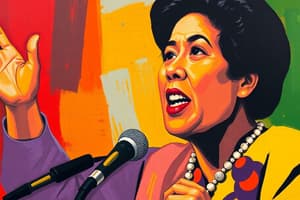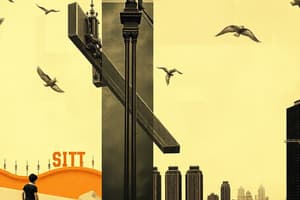Podcast
Questions and Answers
This surprise attack took place in the early morning of december 7, 1941, hawaiian time on december 8, 1942, american government ask the congress to declare war against the ______
This surprise attack took place in the early morning of december 7, 1941, hawaiian time on december 8, 1942, american government ask the congress to declare war against the ______
Japan
THE 3RD PHILIPPINE REPUBLIC July 4, 1946 - The Philippines was liberated from Japanese control with Manuel Roxas and Elpidio Quirino as ______
THE 3RD PHILIPPINE REPUBLIC July 4, 1946 - The Philippines was liberated from Japanese control with Manuel Roxas and Elpidio Quirino as ______
President
The death of Pres. Roxas in April 1, 1948 paved way for the presidency of Quirino until ______
The death of Pres. Roxas in April 1, 1948 paved way for the presidency of Quirino until ______
1953
Ramon Magsaysay succeeded the presidency but was unable to finish his term on March 17, 1957 due to ______
Ramon Magsaysay succeeded the presidency but was unable to finish his term on March 17, 1957 due to ______
Magsaysay’s death allowed Carlos Garcia become the President and followed by Diosdado Macapagal and was defeated by Ferdinand Marcos in ______ Presidential Election
Magsaysay’s death allowed Carlos Garcia become the President and followed by Diosdado Macapagal and was defeated by Ferdinand Marcos in ______ Presidential Election
After a four (4) year term of Marcos in 1965, he was reelected to the Presidency in ______
After a four (4) year term of Marcos in 1965, he was reelected to the Presidency in ______
In September 21, 1972 - proclamation No. 1081 or declaration of the Philippines under the ______
In September 21, 1972 - proclamation No. 1081 or declaration of the Philippines under the ______
The 1935 Constitution was amended and replaced by the 1973 Philippine Constitution. Martial Law remained until January 17, 1981 and gave birth in the Fourth Republic on July 30, ______ through a plebiscite on April 7, 1981
The 1935 Constitution was amended and replaced by the 1973 Philippine Constitution. Martial Law remained until January 17, 1981 and gave birth in the Fourth Republic on July 30, ______ through a plebiscite on April 7, 1981
THE CORAZON AQUINO TIMES August 21, 1983 - killing of Senator Benigno S. ______
THE CORAZON AQUINO TIMES August 21, 1983 - killing of Senator Benigno S. ______
______ presidency, EDSA People Power Revolution
______ presidency, EDSA People Power Revolution
Flashcards are hidden until you start studying
Study Notes
Philippine Government Timeline
- Corazon Aquino's husband, Benigno Aquino Jr., was a critic and political rival of Ferdinand Marcos.
- Marcos called for a snap election on February 7, 1986, amidst nationwide protests and demonstrations against him.
1986 Snap Election and People Power
- Corazon Aquino ran for presidency with Salvador Laurel as her vice president against Marcos and Arturo Tolentino.
- The election was allegedly marred by widespread cheating, leading to the EDSA People Power uprising from February 22-25, 1986.
- Aquino was declared the President of the Philippines at Club Filipino.
Post-Marcos Regime
- Fidel V. Ramos became president in 1992.
- Joseph Estrada became president in 1998 but was ousted in 2001 amid allegations of cronyism and corruption.
- Gloria Macapagal Arroyo took over as president to finish Estrada's term and won the 2004 presidential election.
- Benigno Simeon Aquino III, son of Corazon and Benigno Aquino Jr., became president in 2010.
Decentralized Government
- Decentralized governance involves delegating authority to lower officials to resolve problems within their capabilities.
- This allows for empowerment and decision-making at the local level.
Philippine Constitution Background
- The Philippine government has undergone various stages of development, with significant events shaping the country's governance.
Pre-Spanish Government
- The Philippines was occupied by various waves of migrants from neighboring islands.
- The barangay was the local government unit, ruled by nobles who imposed rules and maintained peace and order.
Historical Events
- The surprise attack on Pearl Harbor on December 7, 1941, led to the US declaring war on Japan.
- The Philippines was liberated from Japanese control on July 4, 1946.
- The country has undergone various transitions in governance, including the Third Republic, Marcos years, and the Corazon Aquino era.
Studying That Suits You
Use AI to generate personalized quizzes and flashcards to suit your learning preferences.




